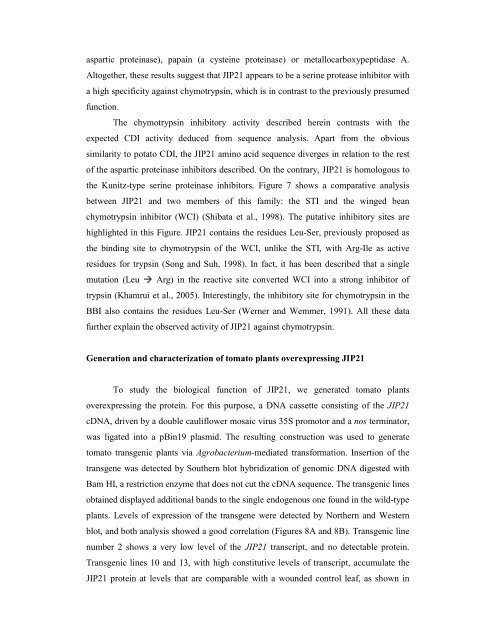Tomato CDI as a Strong Chymotrypsin Inhibitor ... - Plant Physiology
Tomato CDI as a Strong Chymotrypsin Inhibitor ... - Plant Physiology
Tomato CDI as a Strong Chymotrypsin Inhibitor ... - Plant Physiology
Create successful ePaper yourself
Turn your PDF publications into a flip-book with our unique Google optimized e-Paper software.
<strong>as</strong>partic protein<strong>as</strong>e), papain (a cysteine protein<strong>as</strong>e) or metallocarboxypeptid<strong>as</strong>e A.<br />
Altogether, these results suggest that JIP21 appears to be a serine prote<strong>as</strong>e inhibitor with<br />
a high specificity against chymotrypsin, which is in contr<strong>as</strong>t to the previously presumed<br />
function.<br />
The chymotrypsin inhibitory activity described herein contr<strong>as</strong>ts with the<br />
expected <strong>CDI</strong> activity deduced from sequence analysis. Apart from the obvious<br />
similarity to potato <strong>CDI</strong>, the JIP21 amino acid sequence diverges in relation to the rest<br />
of the <strong>as</strong>partic protein<strong>as</strong>e inhibitors described. On the contrary, JIP21 is homologous to<br />
the Kunitz-type serine protein<strong>as</strong>e inhibitors. Figure 7 shows a comparative analysis<br />
between JIP21 and two members of this family: the STI and the winged bean<br />
chymotrypsin inhibitor (WCI) (Shibata et al., 1998). The putative inhibitory sites are<br />
highlighted in this Figure. JIP21 contains the residues Leu-Ser, previously proposed <strong>as</strong><br />
the binding site to chymotrypsin of the WCI, unlike the STI, with Arg-Ile <strong>as</strong> active<br />
residues for trypsin (Song and Suh, 1998). In fact, it h<strong>as</strong> been described that a single<br />
mutation � (Leu Arg) in the reactive site converted WCI into a strong inhibitor of<br />
trypsin (Khamrui et al., 2005). Interestingly, the inhibitory site for chymotrypsin in the<br />
BBI also contains the residues Leu-Ser (Werner and Wemmer, 1991). All these data<br />
further explain the observed activity of JIP21 against chymotrypsin.<br />
Generation and characterization of tomato plants overexpressing JIP21<br />
To study the biological function of JIP21, we generated tomato plants<br />
overexpressing the protein. For this purpose, a DNA c<strong>as</strong>sette consisting of the JIP21<br />
cDNA, driven by a double cauliflower mosaic virus 35S promotor and a nos terminator,<br />
w<strong>as</strong> ligated into a pBin19 pl<strong>as</strong>mid. The resulting construction w<strong>as</strong> used to generate<br />
tomato transgenic plants via Agrobacterium-mediated transformation. Insertion of the<br />
transgene w<strong>as</strong> detected by Southern blot hybridization of genomic DNA digested with<br />
Bam HI, a restriction enzyme that does not cut the cDNA sequence. The transgenic lines<br />
obtained displayed additional bands to the single endogenous one found in the wild-type<br />
plants. Levels of expression of the transgene were detected by Northern and Western<br />
blot, and both analysis showed a good correlation (Figures 8A and 8B). Transgenic line<br />
number 2 shows a very low level of the JIP21 transcript, and no detectable protein.<br />
Transgenic lines 10 and 13, with high constitutive levels of transcript, accumulate the<br />
JIP21 protein at levels that are comparable with a wounded control leaf, <strong>as</strong> shown in

















